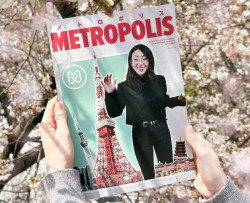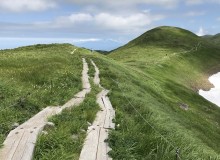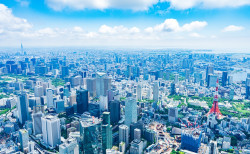
Originally published on metropolis.co.jp on May 2013

Make plans for some unique trips this summer. The sand dunes of Tottori host everything from adventure sports to camel rides; the Jomon-era archaeological sites of northeastern Tohoku enlighten you on Japanese pre-recorded history; and the mountains and rivers of Saitama’s Chichibu region provide fresh air just a couple of hours from Tokyo.
Sandblasting in Tottori
By Bryan Baier
Tottori is the least populated and one of the least visited prefectures in Japan.North of Okayama on the Sea of Japan coast, the place is most famous for its sand dunes, or sakyu. Walk to the dunes from Tottori City’s main train station in a little over an hour, or take a bus to the Tottori Sakyu stop—and save your legs for your desert safari. The best time to visit the undulating formations is in the morning, before visitors and camels kick up the sand. Take a break from the dust and sun at the worthwhile Sand Museum.
Sandboarding

With the deep blue Sea of Japan in front of you, the pine forests and mountains at your back, and yellow-white dunes all around, the setting is ripe for sandboarding.
There are some small drops on the dune face for anyone confident enough to take them. A warning to snowboarders making the transition: the sand grips the edge of your board tighter than snow does. Dig in too deep and you’re going down. Your weight will also need to be on your back foot. Get used to these two things and you’re good to go.
Those with limited or no experience in board sports needn’t worry, as the soft sand is unlikely to cause injury to anything other than your pride—though it will get it into crevices you didn’t know existed. Bring sandals and a water bottle, as well as a pair of socks, and clothes you aren’t worried about getting dirty.
While there is a ski lift at the dunes, it doesn’t serve the sandboarding area, so be ready to climb back up. A two-hour course costs ¥2,500, including board and helmet rental, plus the guidance of an instructor. The assembly point for sandboarding (and paragliding) is the Rakudaya Omiyage store across the street from the lift.
Sandboarding is a seasonal activity, offered from mid-April to the end of November. Reservations are necessary (Tel: 0857-23-1749), and a little Japanese will be of great help.
Paragliding
[pictured top]
The soft sand makes the dunes an ideal place to try paragliding for the first time. A half-day course (four hours) with Zero Paragliding School (Tel: 0857-29-9098) is a very reasonable ¥7,000. More exciting still, you won’t be flying tandem—it’s all you. Run down the slope from the top of Uma no Se (the biggest, tallest dune) toward the Sea of Japan until your feet part company with ground. Your megaphone-wielding instructor helps everything go smoothly. Touch down on the beach, re-pack your canopy, and climb back up for another go.
Getting there from Tokyo
There are four ANA flights per day from Haneda to Tottori Airport; the 75-minute flight is a costly ¥30,000 each way without advanced-booking or discounts. Shinkansen to Himeji and then the Super Hakuto Limited Express will get you from Tokyo to Tottori in five hours at ¥17,250 for non-reserved seats. Or take the “Camel” night bus from Shinagawa or Hamamatsucho to Tottori for ¥10,200. The 10-hour trip passes quickly while you sleep.
Archeology in Akita and Aomori
By Justin Velgus

Pack your Indiana Jones hat and head to Honshu’s northernmost capital city for a visit to the past in Aomori. From there head south past Lake Towada, into Akita Prefecture near Oyu, where you’ll find Japan’s answer to Stonehenge. Plunge along this route into some fantastically rustic onsen
(Tsuta and Aoni are two of the best); spending the night is highly recommended.
Sannai-Maruyama Site
Voyage 5,000 years back in time to the Stone Age Jomon Period (14,000-300BCE), when agriculture was still in its infancy. At this dig the former inhabitants’ struggle to survive is documented, as well as the surprising advancement of Jomon society for the time, shown in dwellings, pottery, tools, graves, and even remains of roads.
The free-entry Sannai-Maruyama site lies 20 minutes from Aomori station by bus and will take about two hours to explore. Be prepared for some walking. Remains can be seen of village foundations within several of the site’s dome buildings. Make sure you find the active workshop where archaeologists reassembe pottery fragments.
Before leaving, stop at the fascinating museum. Stone tools, ancient fishing hooks and reconstructions of ancient scenes are to be explored, and visitors can even try on period clothing for photo opportunities. Near the exit a mountain of reassembled pottery towers above other exhibits with a stunning design woven into it.
Oyu Stone Circles
The Jomon settled primarily in northern Japan in the Tohoku region, leaving behind another unique sight —Akita Prefecture’s Oyu Stone Circles. By no means as large as Stonehenge, the two formations nonetheless cast a spell of mystery that has lived on for several millennia.
Different from similar structures elsewhere in Asia and the rest of the world, the design of these formations is what most impresses. Both Oyu circles have a central pillar with flat stones radiating out in a sundial pattern. Despite the circles being over 40m in diameter, their diminutive height means a winter visit could find them completely covered by snow.
Stones were carried from the nearby Akuya River, a little more than 5km away. But debate continues among researchers as to what the purpose the stone circles served. It has been suggested they were for social gatherings, or burial sites, as human remains have been found by archeologists nearby. The sundial designs suggest rituals coinciding with astrological events, and many experts believe the formations were places of religious worship. Japan’s native religion emphasizes harmonization with nature, and the ancient builders appropriately selected a picturesque setting with gentle hills in the distance.
Since daily artifacts—but no evidence of human dwelling—have been found near the circles, some have argued that the stones were used for ceremonies, perhaps to improve chances of a harvest or a hunting expedition. In reality, the sites were probably used for multiple purposes by different tribes over the centuries.
To gain a better perspective on the stone-circle creators’ daily lives, step inside the museum. Although exhibits are in Japanese, all visitors can enjoy models of the stone circles and ancient dwellings. Artifacts are also on display, as well as an interactive exhibit where you can test your pottery reassembling skills.
Getting there from Tokyo
ANA and JAL flights to Akita cost about ¥24,000 one-way, and JAL connects with Aomori for about ¥30,000. Military travelers may be able to take advantage of the Misawa Air Base—just over an hour from Aomori station by train. Shinkansen to Akita or Aomori takes around four hours and runs from ¥16,000 one-way. Night buses are a good economical option to both destinations.
Outsiders in Nagatoro

The entire town of Nagatoro in Saitama Prefecture, just two hours from Tokyo, is a designated prefectural natural park, with the gorgeous Arakawa River rushing through its heart.
Nagatoro Iwadatami
At the side of Arakawa River, rocks up to 80m by 500m are splayed out, resembling tatami, hence the name meaning—you guessed it—“rock tatami.” Japan’s first scenic natural monument was created naturally by changes in the earth’s crust, combined with river erosion.
Locomotive
Nagatoro station is a piece of civic history—it was constructed in 1911 to feature a Western-style structure that was the last word in modernity back then. The Paleo Express steam locomotive makes regular seasonal stops here.
529- 2 Nagatoro Nagatoromachi. Tel: 0494-66-0002. www.chichibu-railway.co.jp
Boating
Board a traditional Japanese boat and be punted by pole along the Arakawa River. The green and rocky Horaijima, along with the precipitous cliffs of Chichibu-Sekiheki—aka the “Red Walls of Chichibu”—provide the scenery.
Full course (6km) Adult ¥2,900/ Children ¥1,300. Half course (3km) Adult ¥1,550/ Children ¥750. Open: 9am-4pm. Nagatoro Line-Kudari. Tel 0494-66-0950. www.chichibu-railway.co.jp/line
Hodosan Jinja
At the foot of Mt. Hodo, this shrine was built almost 2,000 years ago, and has had generations of visitors come to pray for protection against disaster, theft, and hardships. Multicolored dragon sculptures come alive against the natural backdrop.
1828 Nagatoro Nagatoro-machi. Tel: 0494-66-0042. www.hodosan-jinja.or.jp
Seven Flower Temples
In case you didn’t know, the seven flowers of autumn are Japanese bush clover, Japanese pampas grass, arrowroot, fringed pink, golden lace, boneset, and balloon flower. Tour the town on foot or by bike and visit these seven temples, each of which displays one of the flowers. Tosho-in; Dokoji; Henjoji; Fudou-ji; Shinshoji Temple; Hozenji; Tahoji.
Funadama Matsuri
This annual summer festival is held every year on August 15 in Nagatoro. Its origin lies in requesting that the gods of water protect the boatmen. The event features mantosen, which are boats that carry stacks of lanterns, and 3,500 fireworks from both banks on Arakawa River.
Getting there from Tokyo
Seibu-Ikebukuro line from Ikebukuro to Seibu-Chichibu on the (80min, rapid express), then from Chichibu Railway Ohanabatake to Nagatoro (20min). JR Takasaki line from Ueno to Kumagaya on the (60min), then to Chichibu Railway Nagatoro (50min).
Nagatoro Tourist Information. Tel: 0494-66-3311. www.nagatoro.gr.jp







